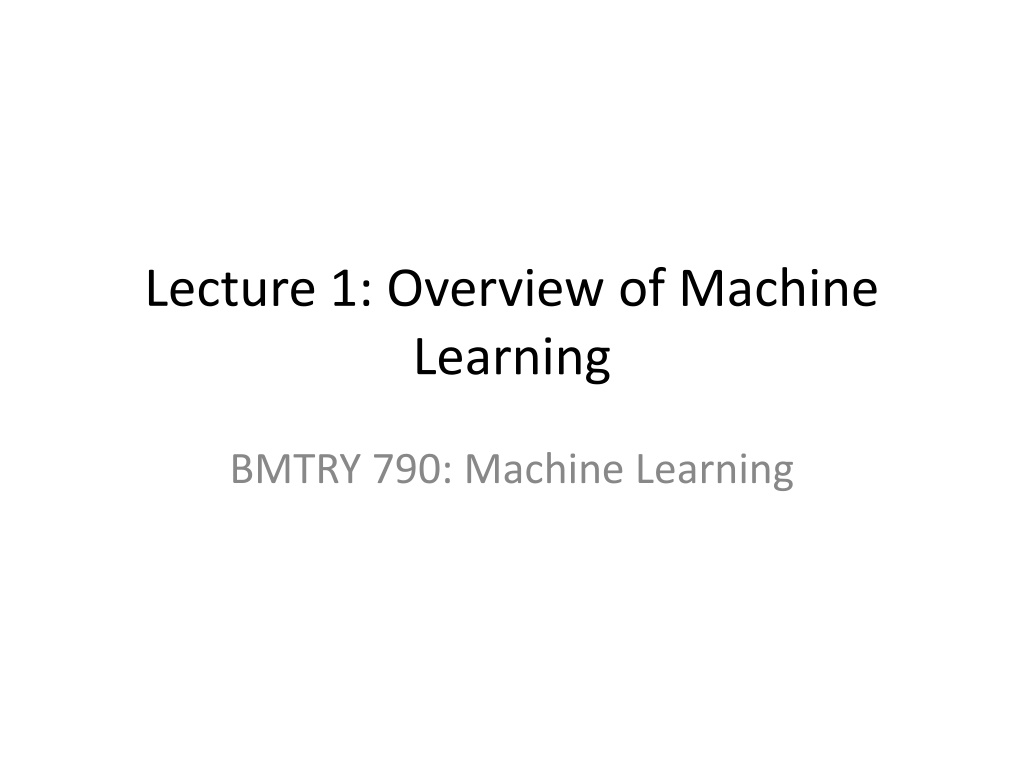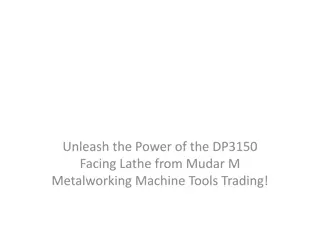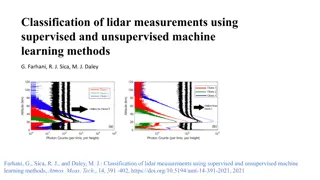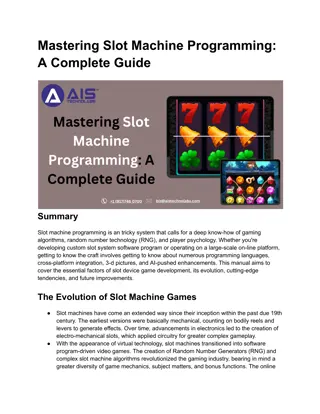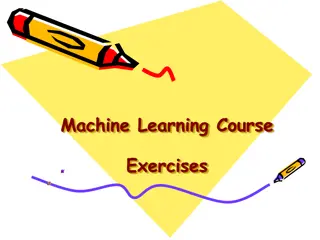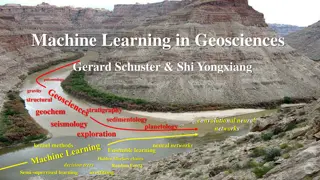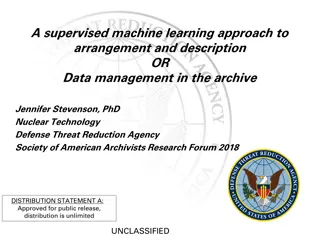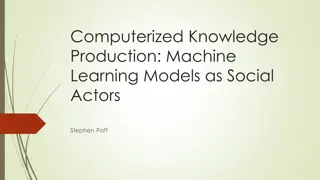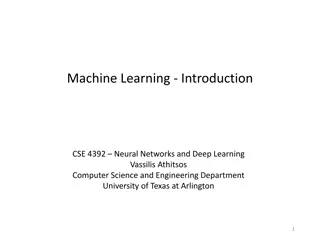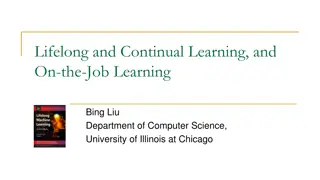Introduction to Machine Learning in BMTRY790 Course
The BMTRY790 course on Machine Learning covers a wide range of topics including supervised, unsupervised, and reinforcement learning. The course includes homework assignments, exams, and a real-world project to apply learned methods in developing prediction models. Machine learning involves making computers adapt their actions for accurate predictions. Supervised learning uses training data with predictors and responses, unsupervised learning identifies similar observations, and reinforcement learning teaches algorithms through rewards and penalties. Visit the course website for more details.
Uploaded on Sep 21, 2024 | 0 Views
Download Presentation

Please find below an Image/Link to download the presentation.
The content on the website is provided AS IS for your information and personal use only. It may not be sold, licensed, or shared on other websites without obtaining consent from the author. Download presentation by click this link. If you encounter any issues during the download, it is possible that the publisher has removed the file from their server.
E N D
Presentation Transcript
Lecture 1: Overview of Machine Learning BMTRY 790: Machine Learning
General Information Website: http://people.musc.edu/~wolfb/BMTRY790_Spring2023/BMTRY790_2023.htm Office: 302B, 135 Cannon Place Phone: (843)876-1940 Email: wolfb@musc.edu Office Hours: By appointment
Homework 4-5 homework assignments worth 60% of your grade. Include some theory, application of software, as well as writing your own code. Should be submitted electronically. Scan hand-written homework send electronic copy. Due 1 week after it is assigned unless otherwise noted. One day late will receive a 25% reduction, two days late will receive a 50% reduction, more than two days late will not be accepted.
Exam There will also be one mid-term exam that constitutes 20% of your grade. The exam will consist of: Theory of statistical learning algorithms Writing pseudo code for programming statistical algorithms Comparison of different statistical learning algorithms.
Project Designed to simulate a real problem you may face once you ve graduate- how to choose from among different modeling techniques. The goal will be to use the methods learned throughout the class to develop a prediction model for real-world data.
What is Machine Learning Making computers adapt or modify their actions to lead to a more accurate actions Examples of actions Predicting a patient s response Identifying subsets of similar observations Extraction of features relevant to an outcome
Types of Machine Learning Supervised Have a set of training of observations with both predictors and response(s) Unsupervised Have a set of features but no response is provided Goal is to identify similar observations
Types of Machine Learning Reinforcement Between supervised and unsupervised Algorithm told when it is right or wrong Rewarded for correct action Penalized for mistakes Examples include things like teaching a computer to play a game i.e. what is the best move to make at this time?
Vocabulary: Statistics vs. ML Dependent Variable (Y, G, t) Response Outcome Target Output Independent Variables (X) Predictors Features Inputs
Goal In Machine Learning General goal discover patterns in data through the use of algorithms use these patterns to take some action Examples?
Goal In Machine Learning In a more mathematical/statistical context Given input features x Find a function f (x) that does a good job of predicting/estimating an outcome y Linear regression is an example of this ( ) f x = = x ' y Ideally we want the results from our learner to be generalizable
Simple Example We want to understand bioavailability of iron in rainwater to phytoplankton Iron is a limiting nutrient and certain forms of iron are more available for phytoplankton to use Ionic iron (Fe2+or Fe3+) are more available than colloidal iron (e.g. Fe2O3 = rust). Major source of iron in the open ocean is from rainwater We want to evaluate if there is a relationship between time of day with Fe3+
Simple Example We observe some real-valued input variable x = time for 10 rain events and we want to predict y = Fe3+ This is a problem we are familiar with What is one approach we might take?
Simple Example Let s say we run a regression model
Coefficients with Increasing Order M=0 M=1 M=3 M=6 M=9 b0 -0.112 0.721 -0.014 0.052 0.068 b1 -1.852 8.692 2.564 -16.590 b2 -27.218 38.797 244.86 b3 18.504 -258.484 693.33 b4 555.678 -19609.9 b5 -533.186 102882.1 b6 196.115 -257122.5 b7 343211.3 b8 -235721.8 b9 65522.27
Another Simple Example Consider an example where we have a data set with 2 features x1and x2and an output variable, y, with two classes e.g. classify Cooper River Bridge run participants as runners/walkers based on chip time and age We want to develop a prediction rule for determining the class of y based on x1and x2 i.e. find some yields a good prediction ( ) y f x = What methods might we use that we know already?
Linear Regression Approaches We could simply develop a linear model How can we use the output to classify y and develop a decision boundary?
Linear Regression Approaches Decision boundary from linear regression model
Linear Regression Approaches Alternatively we could use a link function i.e. logistic regression How can this type of mode be used to develop a decision boundary
Linear Regression Approaches Decision boundary from logistic regression model
Caveats Linear classifiers yield relatively stable predictions However, we make relatively large assumptions about the association between y and our features x Classes are linearly separable Inputs/predictors are independent Independence of errors There are (many?) times when these assumptions are unreasonable
Alternatives The regression approaches are model based and assume a specific relationship between X and Y There are many alternatives to traditional linear regression classifiers Here we briefly examine 1 nearest neighbors
Nearest Neighbors Idea: use the k observations closest to point xito develop a decision boundary to determine the predicted class Mathematically we can express this as follows 1 k ( ) = Y x y i ( ) x x N i k There are certainly fewer assumptions but what assumption does this still make?
Caveats for kNN Requires fewer assumptions and can adapt to any scenario However, sub-regions of the decision boundary are determined by only a small subset of the training observations Results is that kNN often produced unstable estimates
Loss Functions In trying to define f (X) to predict Y given our values of X, we need to choose a loss function to penalize prediction errors. Familiar loss functions squared error loss: absolute error loss: zero one loss
Loss Functions Selecting the loss function leads us to a criterion for choosing Goal is to minimize the expected loss
In Context of LR and kNN? Thus for regression our best estimation of Y when X=x is the conditional mean of Y at X=x. The NN approach directly implements this idea in local regions in the training data Expectation approximated by average all yi s in the neighborhood of X=x ( ) ( Ave i f x y x ) ( ) x = N i k Conditioning on relaxed region close to observation X=x
Curse of Dimensionality Refers to problems with analyzing high-dimensional data that do not occur in low-dimensional settings. As the number of features increases, the feature space volume increases so fast that the data become sparse. Result is that our intuition breaks down as dimensions increase.
Curse of Dimensionality If evaluating statistical significance, the amount of data needed to support the result often grows exponentially with the dimensionality For discovery (i.e. discover patterns), organizing and searching the data relies on detecting areas where objects form groups with similar properties In high dimensional data, all objects may appear to be sparse, which prevents common data organization strategies from being efficient
Consider Our Examples Polynomial fit We considered a case with only a single variable But what happens if we consider D variables? ( ) f x D D D D D D = = + + + + y ... x x x x x x 0 j j jk j k jkl j k l = = = = = = 1 1 1 1 1 1 j j k j k l M For an -order polynomial, the growth of the coefficients is proportional to M D
Consider Our Examples k-NN: We considered a case with two variables Consider two classed based on D inputs uniformly dispersed in a D-dimensional hypercube of unit volume Want capture hypercubical neighborhood around a target point to capture a fraction r of the unit volume Expected edge length is eD(r) = r1/D In 10 dimensions for r = 0.1 this means e10(0.1) = 0.80 However, the range of each input is only 1.0
More on Supervised Learning Start with assumptions that data come from a model Y = f(x) + where E( ) = 0 and is independent of X Here f(x) = E(Y|X = x) Goal of supervised learning is to learn f by example Learning algorithm can modify the input/output relationship based on f ( ) f x y i i
Function Approximation Data {xi, yi} considered (p+1)-dim Euclidean space f(x) has domain of p-dim input space and is related to data via a model like yi = f(xi) + Goal to obtain useful approximation for f(x) based on all x Many approximations include estimated set of parameters Linear regression: f(x) = x = More general: (linear basis expansion) ( ) 1 k f x = = ( ) x K h k k
On Writing R Functions Idea: Objects created within a function are local to the environment of the function They don t exist outside of the function. But you can return a value(s) of the object from the function Can be used in other functions Can summarize results of task the function completed
Why Write Your Own Functions? Easy way to conduct simulations for method evaluation Standardize code you use often Once function written, need one line of code to run your analysis e.g. plotting functions to summarize results Developing and disseminating new methods
Basic Function Format Need a function name Arguments (generally at least) Body of code that does some task Final object the function returns (not necessary)
Pseudo Code- Simple Example What do we need to generate our data sin(x) example
Pseudo Code- Simple Example What do we need to generate our data sin(x) example
More Complex Example polyfit<-function(dat, maxpol) { models<-vector("list", maxpol+1) prd<-matrix(0, nrow=nrow(nxs), ncol=maxpol) tst<-myfunc(100) prdtrn<-errtrn<-matrix(0, nrow=nrow(dat), ncol=maxpol) prdnew<-errnew<-matrix(0, nrow=100, ncol=maxpol) model.basis<-lm(y ~ 1, dat) models[[1]]<-model.basis$coef for (i in 1:maxpol) { modi<-lm(y ~ poly(x, i, raw=TRUE), data=dat) models[[i+1]]<-modi$coef prdtrn[,i]<-predict(modi) errtrn[,i]<-(prdtrn[,i]-dat$y)^2 prdnew[,i]<-predict(modi, newdata=tst[,2]) errnew[,i]<-(prdnew[,i]-tst$y[1:94])^2 } ans<-list(models=models, ptrn=prdtrn, etrn=errtrn, pnew=prdnew, enew=errnew) return(ans) }
